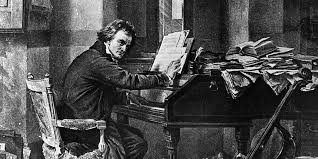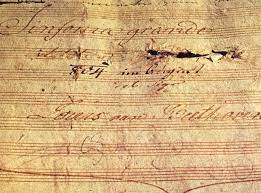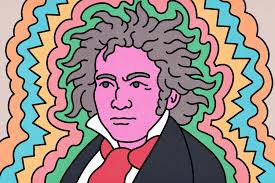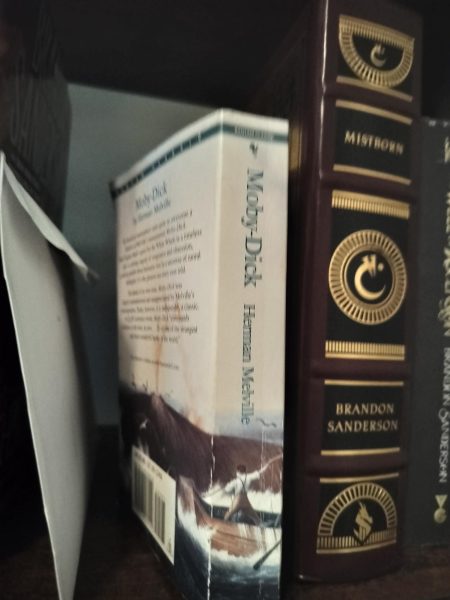High Scores: Beethoven’s “Eroica”
Emotion and reason. An analysis of Beethoven’s Symphony No.3 in E flat.
Several things come to mind when we think of the name “Beethoven.” We see of course that furrowed brow, the trademark shock of gray tufts, those intense, hazel dots boring back at us out of Stieler’s famous portrait. We may hear the famously jarring, four-note start of his fifth symphony, for example, or the gloriously sublime, half-hour ending to the ninth. For some he is as much of a giant as Brahms said, a kind of Einstein or Galileo to musicians classical and non-classical. For others, the name itself may be a turn-off, synonymous with “old” or even “boring.” Not just boring but something we can’t make sense of, a music that may sound nice but never interesting.
To each their own, but this stuff is anything but uninteresting.

It’s never only one thing going on; D minor and B flat major, Symphony for Orchestra with Chorus, Ode to Joy, and Brotherhood. Getting to know Beethoven means learning to appreciate all the different elements that make up his music, how they interact, complement, even contest each other. I propose a short voyage through one of the master’s most popular works: the thrilling “Eroica” Symphony in E flat major. With twelve different instruments and a million notes, this may seem tedious at first, but do not despair! A playlist has been provided below.
Two thunderbolts break the silence and announce the work’s tonic key, a fearless and resolute E flat Major. The corks have been popped from this great barrel of invention, and out flows a quiet, meandering tune in the cellos, the Allegro’s main theme. Like the chorus of a pop hit, we will hear this melody time and again

throughout the movement. Only with Beethoven, it’s not staying put for long. The line ends on a C-sharp, a note completely foreign to the key we’ve just established. Our ears dot expect this dissonant stumble, and the violins instantly back away into the home tonality. The effect stays with us, however; something is amiss. That last vexing note makes it clear the journey won’t be as easy as we thought, for our guiding melodic strain is incomplete.
Take the opening bars of Doja Cat’s Woman for example. The repeated “Your Woman” motif occurs twelve times in the same musical fashion, with some lyrical variation. The motto doesn’t change because it doesn’t need to; nothing is out of place or “unresolved.” Beethoven gave himself the extra work of writing material requiring some amount of compositional TLC to sound cohesive and satisfying. This process, known as development, is the trademark of symphonic writing. What the composer does to their themes, what kind of secret harmonic sauce they add to the mix, is what sets apart the best from the rest in classical music. After a lyrical, chorale-like second theme is passed between the strings and winds, the first part of this movement, the exposition, comes to a boisterous conclusion with the same bright triads as the beginning.

Now, Beethoven gets to work. Instead of backing away from the C-sharp this time, our heroic first theme wanders deeper into a dense E Minor, fighting off relentless sforzando (suddenly loud) descending scales in the upper strings. This wandering has consequences, and the struggle to “return home” will take time. Each repetition of the themes gets another layer darker, until the music’s frustration and rage culminate in a new set of full-orchestra chords, played this time with the C-sharp! We have succumbed fully to this nemesis of an accidental, now a D-flat in the melancholic, E-flat minor third theme played by an oboe.
After so much conflict, so much turmoil in getting where we are now, this pensive melody evokes exhaustion, the clearest portrait of yearning Beethoven has given yet. Even when the music finally winds back into major, these feelings of sorrow and searching never truly disappear. Only gradually is old Ludwig able to build up a truly confident ending, spurred on by rapid string tremolos and a famously out-of-place horn solo.
If the first movement is about life, light, and action, the second is most certainly about death, in all it’s public and personal implications. Titled Marcia Funebre (funeral march), it invokes the opulent processionals of Beethoven’s time, where the body is carried through the streets on its way to burial. The swaying drone of the strings mimics the sound of drums, over which the oboe and bassoon eulogize. “Why?” they seem to ask. How is it that people die? Must this be? These questions are further pondered in the most logical of forms: the fugue.

A fugue is where a certain melodic subject is heard in one register, or voice, and is passed along through several others before climaxing in the original key. Amidst the chaos and helter-skelter of the piece, this movement stands out for its passive, almost serene quality. Several historical figures have had it played for their own funerals, including composer Felix Mendelssohn and U.S. presidents Franklin Roosevelt and John F. Kennedy.
The third movement of a classical symphony is typically a scherzo, or “joke.” After the gloom and grandeur of the funeral march, we have earned some light-hearted fun with this puckish chuckle of a melody, first heard in hushed strings and then later with full, fortissimo (very loud) gusto in 6/8 time. At the heart of every scherzo lies a trio section, played here as a call and response between the horns and orchestra. This was one of the first symphonies to add a third horn, enabling full triads in the horns alone. The brisk, technically difficult horn passages in the trio evoke the bugle calls of hunters, giving this cheery interlude a pastoral character.
The final movement of the symphony functions as a massive theme and variations. The bass line of the theme first appears and then is subjected to a series of strophic variants leading to the full appearance of the theme proper. After a fugal treatment of the main theme, the orchestra pauses on the dominant of the home key, and the theme is further developed in a new section marked Poco Andante (a little slower). The symphony concludes in a bang, with a Presto (very fast) coda which recalls the opening of the finale and ends in a flurry of sforzandos.

Joseph is a WCHS Senior, and returning editor and staff reporter for The Jacket Journal. An avid cellist, he participates in Woodford's Chamber Orchestra...










